[ overview | the course | my race day | race telemetry | thanks ]
Overview
If you race in an Ironman, you're going to encounter suffering and adversity. To finish an Ironman, you have to find ways to overcome both. Having this experience is probably why you chose to race in the first place. The inaugural Ironman St. George was a big success, delivering plenty of pain and suffering, but providing ample opportunity to overcome it. Along the way, it took athletes through one of most beautiful courses in North America.
If you try this race, you will encounter what's billed as the toughest North American Ironman course. From the course profiles and description, you'll notice the double loop over the mountains of Snow Canyon state park, so you'll expect a tough ride. What you can't see are all of the other challenges: the cold-water swim in the reservoir, the stiff head- and cross-winds you'll encounter on your ride, and the mercilessly constant up and downhill of the marathon course. Happily, the logistical support from the race organizers and the local volunteers was excellent, so with the right gear, you can have a great day of racing.
The course
St. George is in southwestern Utah, and it has that very Utah-esque combination of wide-open flats, gorgeous red stone canyons, and surprisingly big mountains. In May, the daytime temperature can range anwhere from 60 to 90 degrees, and more often than not, a hard and dry wind blows from the north.
Swim: The swim leg takes place in Sand Hollow reservoir, a 20-mile drive to east of St. George. Early in the morning, there is a chill in the air. As a result, you'll find most of the athletes huddling inside the T1 change tent until the last minute to stay warm. Bring track pants, a skull cap, and a nice warm top.

The reservoir itself is just big enough to accomodate a single loop, 2.4 mile swim. Around dawn there's not much wind, so we were treated to very flat water. The course itself is a big counter-clockwise rectangle. The sun is at the horizon, and during part of the swim it can be right in your eyes, but it's easy enough to spot the course buoys and follow the feet in front of you.
Your biggest enemy on the swim will be the water temperature. According to the race directors the water was at 58 degrees, but it felt more like 55. Apparently sixty athletes were pulled from the water because of hypothermia! By the end of the swim, most of the athletes were badly affected by the cold. People were shivering, teeth were chattering, and everybody seemed to lose all dexterity in their fingers. The volunteers had to help to buckle up athletes' shoes and helmets. I'd strongly recommend a full wetsuit, neoprene cap, and even booties if you don't mind losing a minute of time in the water.
Bike: The first 26 miles of the bike course are forgiving, which is lucky, since you'll need them to warm up after the swim. Bring arm warmers at the very least, and go easy but steady for the first hour. Immediately out of T1, you'll hit a few miles of fast, flat road. Next, there is a steady two mile climb once you exit Sand Hollow park, followed by fifteen miles of gentle rollers that take you past St. George and to the town of Santa Clara. It's here that the real work begins.
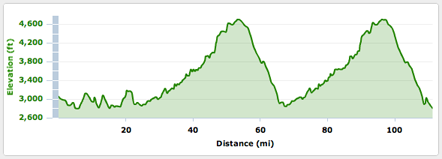
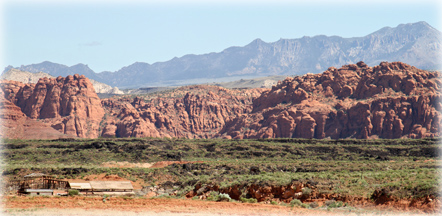
The remaining 86 miles of the bike course consist of two loops over a mountain pass. Each loop has about two miles of flat, followed by 30 miles of steady climbing, culminating with 14 miles of very steep downhill. You'll climb somewhere between 6,000 and 7,000 feet for the day.
Besides the obvious energy and careful pacing you need to handle all that climbing, chances are you'll encounter increasing winds throughout the day. Since you're climbing up valleys and canyons, the hills will act as a wind tunnel, guaranteeing that no matter which way you're facing, the winds will blow squarely in your face.
Because the winds picked up so much, the second loop was much tougher than the first. At the base of the second climb, you'll probably be frustrated with how slowly you're moving, but keep a steady effort going. Once you're out of the exposed, open area and into the canyons, the wind dies down a bit and you can pick up more speed even though you're climbing a steeper pitch. Be prepared for a long grind. If you can, remember where you are, enjoy the spectacle of the race, and soak in the scenery.
You'll find your special needs bag at mile 55, the summit of the first loop. You're going to get a lot of sun, so if you stashed some sunscreen in your needs bag this is a great time to re-apply.
The loop descents are fast: people were hitting 40-50 mph on the steepest parts. Look out, though, since there are some curves with very sneaky gusting crosswinds. Several cyclists crashed hard on this part of the course, including somebody who broke his collarbone and somehow managed to finish the race despite this. Some people were brave enough to ride on disc wheels...personally, I wouldn't go deeper than 404s on the front and 808s on the back.
At the very end of the second loop, you turn towards T2 instead of heading back out of town. There's a nasty little 250 foot kicker right at the 110 mile mark, but once you're over that, it's down into the transition area.
Run: The run is the surprise monster of Ironman St. George. It's a two loop course with absolutely no flat parts. Nearly every inch of the run is either uphill or downhill, and in total, you'll face 2400 feet of elevation gain.
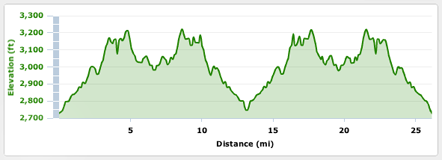
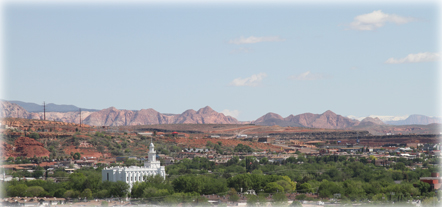
Right out of T2, you begin a long, three mile climb into the hills just north of St. George. Once you've summited, the course takes you along a ridgeline to the east. The good news is that as you approach the turnaround, you'l overlook the town and the finish area. The bad news is that you're only a quarter of the way through the marathon, and you've just encountered several very steep downhill pitches that you'll have to re-ascend on the trip back.
Because it's a two-loop, out-and-back course, you'll probably have plenty of time to see people at all stages of the race, ranging from the pros to the people more at the back of the pack. The aid stations are well-stocked and organized.
If you're out as the sun starts to drop, there will be a significant temperature drop. It can't hurt to stash a long-sleeved synthetic shirt in your run special needs bag, which you'll pick up at the 13.1 mile mark just in front of the finish area. To warm up, some athletes were running with the shiny space blankets that they normally hand out at the finish line.
The cumulative effects of the tough bike course and the constant ascending and descending on the run are rough. Particularly on the second run loop, many of the athletes were walking up the steepest hills. As with the bike course, conservative pacing and careful calorie management will really help you sustain your run through the second half. It's doable, but it's a tougher course than you've probably been training on, so on the first half, slowing your pace to 10-15 seconds per mile below what you'd normally do will pay off.
The finish is fast. The great news is that the three-mile climb out of T2 becomes a three-mile downhill leg into the finish line at the end of the day. If you're good at letting gravity carry you and keeping a fast turnover, you can really rip the last couple of miles and finish feeling strong.
My race day
Pre-race. The alarm clock went off at 3:15am. Since T1 is about 25 miles out of town, all athletes had to converge in the middle of St. George to catch buses leaving the finish area between 4:30 and 5:30am. Since this was the first time this race had been held, I wanted to be there early to avoid any logistical bottlenecks. Happily, parking was easy, and I was on the first bus to the reservoir.
We arrived at T1 at around 5am. Since we were the first bus in, there were no lines or crowds anywhere. After checking on my bike and swim/bike bag, I went into the change tent to hang out until it was time to wander over to the water. It was really cold, and I was underdressed, in spite of having sweatpants, two t-shirts, my race shirt, and a jacket. But, as more athletes started coming into the change tent, the aggregate body heat warmed things up for us.
At 6:20am, I changed into my wetsuit, neoprene hat, surf booties, and gave my morning clothes bag to a volunteer. I joined the parade of athletes wandering over to the swim start area, which is a little sand beach on the edge of the reservoir. I noticed that the water stays pretty shallow near the shore, and the swim course hugs the shore for the first few hundred feet. Since I don't like being in the middle of the churning dishwasher of feet and elbows as the gun goes off, I decided I'd hang back 30 seconds, then stick wide near the shore until things spread out a bit.
Swim. The gun goes off, and I jumped in the water. It was cold: take your breath away cold. I stuck to my plan, hung back for 30 seconds, and then literally waded along the shoreline for two minutes before immersing and starting to freestyle. Happily, I had pretty open water for most of the swim, except for the occasional wayward athlete bumping into me or swimming over my legs.
I tried to keep a solid but not excessive pace. It felt like a long swim, likely because of the cold. The last 20 minutes were really rough; the cold was causing my legs to cramp up, and I was starting to feel the disorientation association with hypothermia. But, I made it to the finish ramp, got some help from the volunteers stripping my wetsuit, and stumbled into the change tent.
T1. OK, this was bad. I was shivering uncontrollably, teeth were chattering, and I didn't have the finger dexterity to unbuckle my booties, let alone assemble my gear. So, I toweled off, and let the body heat of people around me start to seep in. The volunteers were great, but overworked with all the frozen athletes. After a minute or two, one stopped by and helped me to get my socks and shoes on, and buckle up my helmet. I don't think I would have been able to do it without them. After another minute or two of shivering, I decided I'd warm up faster by getting on the move on my bike. So, I headed out, walked the bike to the mount line, and headed out. I turns out I spent almost 14 minutes in T1! Time flies when you lose cognitive ability, I guess.
Bike. Normally when I start the bike leg of a triathlon I have trouble controlling my heart rate. But, because of the extended time I spent in the transition area, and probably because I was still cold, my heart rate settled down quite quickly. So, I cruised at a nice, easy 18 mph pace for the first 20 miles, and warmed up nicely. I started the nutrition pipeline flowing with my Infinit drink mix and power gel. Interestingly, the tri-berry Nuun tablets I dissolved in the Infinit seemed to produce a bad taste combination -- very peppery -- but luckily it didn't cause any nausea, so I was safe for the day's racing.
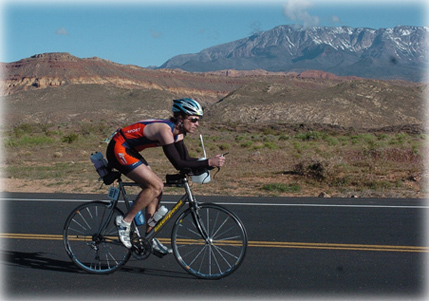
I could tell I was in the middle of the pack, since there were a lot of cyclists packed close together for the first half of the bike leg. It was tough avoiding drafts, just because there wasn't a lot of room on the road: there was always somebody a couple of bike legs in front of you and behind you. But, pretty soon, the road started to tilt up as we hit the first of the climbing loops, and that had the nice side-effect of stringing the packs out.
Given how long the day was going to be, I held back quite a bit on the first loop, holding my wattage at about a 165-170 watt average, even on the climbs. (My FTP is about 235 these days, so that's about 70% of FTP, which is about right for an Ironman.) I was clearly getting enough liquids down, since I was able to use the portapotty once halfway up the climb, at about 2 hours into the ride. The climb was going really well; I felt strong and confident, and even though there were a lot of uphill miles, the grade didn't seem all that bad, and I'd be training for hills all winter.
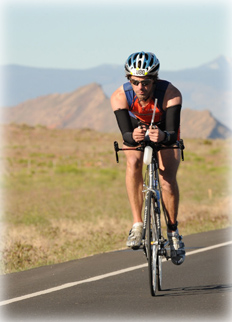
After getting over "the wall," a one mile steep pitch near the summit, I cruised into the bike special needs area at mile 55. My stomach was starting to give me some problems, so I ducked into a portapotty. Unfortunately, the problems turned into full GI yuckiness, and I had to spent a good ten minutes in there, er, clearing it up. My special needs bags had replacement drink bottles, so I made sure to take on a bunch of extra fluids to replenish.
The fun parts of the ride are the descents. But, about a mile into the downhill of the first loop, my front tire went flat! My tube change was quick, and there didn't seem to be any cuts or puntures in the tire itself, so I was good to go. Coming down the hill, I maxed out at 41.9 mph, and held my line in spite of the gusting sidewinds.
Loop two was more tortuous. In between the descent of loop one and the ascent of loop two is about five or ten miles of very mild uphill through Santa Clara and Ivins. It was about 11:30am now, and the headwinds were really raging. Even though my power output was higher than the same spot in the first loop, I could only get to about 12-13 mph, which was very frustrating. Winds really wear me down psychologically, since the harder they blow, the slower you go, and the more time you have to spend fighting them. But, once I made it into the canyons and mountains proper, the wind seemed to die down, and my speed picked back up.
The rest of the climb and descent was uneventful, and saving energy in loop one really paid off. People around me were struggling badly, and I saw quite a few people blow up and take rests on the side of the road. I must have passed about 50-60 cyclists on the second ascent. After another fast descent down from the summit, I eventually cruised into T2 at around 4pm, after 6:55:30 of riding (plus 20 minutes for my extended bathroom break, tube change, and special needs pickup).
T2. In my previous Ironman races, I was completely wasted when I came into T2, and the run was 100% survival. This time, I had energy, and I knew I was going to be able to actually run most, if not all, of the way home. I still gave myself some extra time in T2 to get really set up and let the muscles stretch out a bit. Also, I reapplied sunscreen, took on a bit more fluid, and changed my socks to make sure I started off the run with dry feet. After about eleven minutes in transition, I headed off to run a marathon!
Run. I felt very strong out of the gate, in spite of the fact that the run tilted up right away, and stayed uphill for 3 miles. My plan was to run at an easy, but steady, speed, focusing on my nutrition pipeline. The plan worked very well, at least for the first 15 miles: I kept about a 9 min/mile pace, and was feeling good. Often I worry about some kind of injury flaring, but this season my coach had done a terrific job of ramping my runs up slowly enough that injury never happened. The hills were tough, but I managed to settle into a sustainable grind.
But, starting at about mile 12, I noticed that I was having a very hard time motivating myself to take on calories and fluids. I think I just saturated on gatorade, gel, and soda, and desperately wanted something else. Worse, I could feel the calorie bonk monster stirring, but I just couldn't force myself to eat.
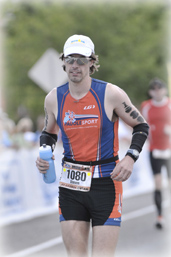
Sure enough, at mile 16, the bonk hit me full on. (I'm sure all of the hill work didn't help either.) I started walk/running: I was walking at a 14 min/mile pace, and every mile or so, I tried to resume my running. As well, I found an aid station that had some nice fruit and cookies, and just lumped it down, even though I still didn't feel like eating. The sun started getting low on the horizon now as well, and the temperature dropped noticably. Even with my arm-warmers on, I was still too chilly; I'm sure walking instead of running factored into this.
It took about 5 miles and 70 minutes, but I eventually recovered from the nutrition bonk, and at mile 21, I was able to resume running at my previous 9 min/mile pace. This felt like a huge accomplishment. Better, at around mile 23, I did some calculations, and figured that I was going to be very close to the 14 hour mark. If I picked up the pace to sub-9-minute miles, I'd make it. Happily, the last three miles were downhill to the finish line, and I stepped on the gas.
I crossed the finished line at 13 hours, 57 minutes, and 55 seconds!! Every time I finish a hard race, all of the pain and suffering melts away in the last half mile, and it feels like I'm running on a cloud. The volunteer catcher at the finish line was amazing, helping me get to the food, and making sure that I was stable and healthy before coming back to the next racer.
It was the hardest full-Ironman I'd ever done. But, I was in the best shape of my life, and I ended up with a 1-hour personal best, and besides the bonk on the run, I exceeded my goals. Success!
Telemetry
Thanks
My coach, Jake Bartholomy, did an exceptionally great job of getting me to the starting line in excellent form. This was no easy task for him, especially given my tendency to injure myself running: finally I had the strength and conditioning I needed to feel strong for the day. Thanks also to Kainoa, Loree, and Laurie from team PauoleSport, especially L&L for doing the early reconnaissance and sending me the GPS tracks of of the course.
